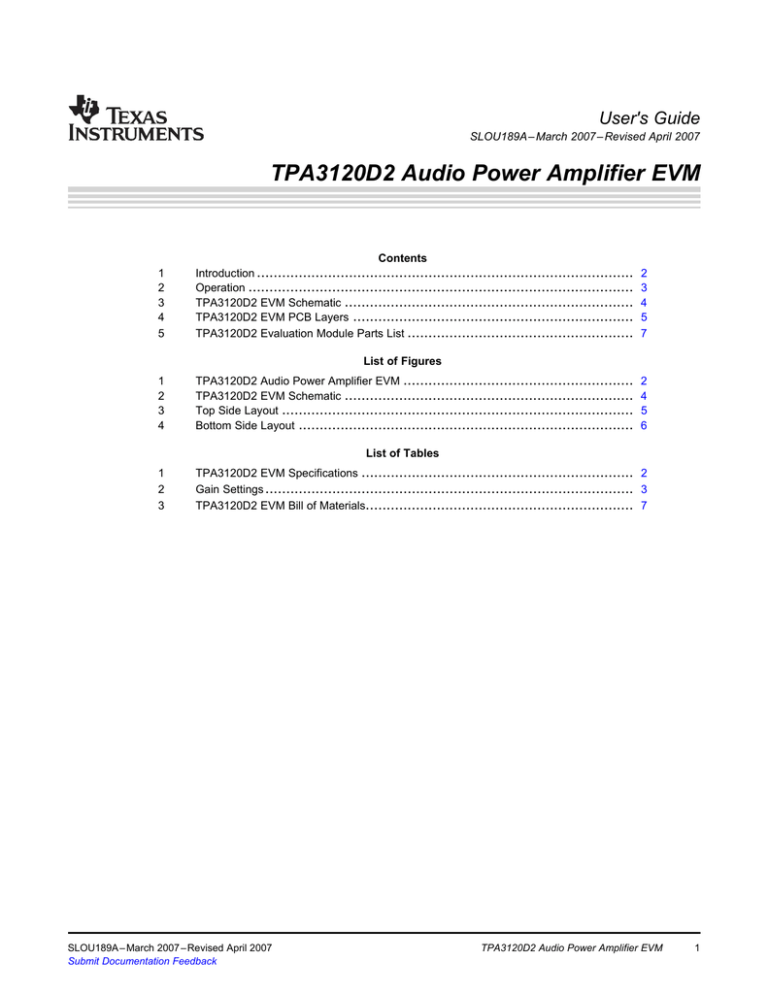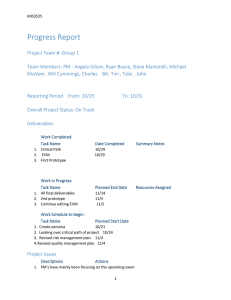TPA3120D2 Audio Power Amplifier EVM (Rev. A
advertisement

User's Guide SLOU189A – March 2007 – Revised April 2007 TPA3120D2 Audio Power Amplifier EVM 1 2 3 4 5 Contents Introduction .......................................................................................... Operation ............................................................................................ TPA3120D2 EVM Schematic ..................................................................... TPA3120D2 EVM PCB Layers ................................................................... TPA3120D2 Evaluation Module Parts List ...................................................... 2 3 4 5 7 List of Figures 1 2 3 4 TPA3120D2 Audio Power Amplifier EVM ....................................................... TPA3120D2 EVM Schematic ..................................................................... Top Side Layout .................................................................................... Bottom Side Layout ................................................................................ 2 4 5 6 List of Tables 1 2 3 TPA3120D2 EVM Specifications ................................................................. 2 Gain Settings ........................................................................................ 3 TPA3120D2 EVM Bill of Materials................................................................ 7 SLOU189A – March 2007 – Revised April 2007 Submit Documentation Feedback TPA3120D2 Audio Power Amplifier EVM 1 www.ti.com Introduction 1 Introduction The TPA3120D2 evaluation module consists of a single 25-W, class-D, stereo audio power amplifier complete with a small number of external components mounted on a circuit board that can be used to directly drive speakers with an external analog audio source as the input. Table 1. TPA3120D2 EVM Specifications VALUE UNIT 10 to 30 V 2 A Continuous output power, PO: 4 Ω, VCC = 27 V, THD+N = 10% 24 W Minimum load impedance 3.2 Ω VCC Supply voltage range ICC Supply current, maximum PO ZL Figure 1. TPA3120D2 Audio Power Amplifier EVM 2 TPA3120D2 Audio Power Amplifier EVM SLOU189A – March 2007 – Revised April 2007 Submit Documentation Feedback www.ti.com Operation 2 Operation 2.1 Quick Start List for Stand-Alone Operation Follow these steps to use the TPA3120D2EVM stand-alone or when connecting it into existing circuits or equipment. Connections to the EVM module can be made by inserting stripped wire, or using banana plugs for the power supply and output connections. The inputs accept standard RCA plugs. 2.1.1 2.1.2 Power Supply 1. Ensure that all external power sources are set to OFF. 2. Connect an external regulated power supply adjusted from 10 V to 30 V to the module VCC (J7) and GND (J8) banana jacks taking care to observe marked polarity. Evaluation Module Preparations Inputs and Outputs: 1. Connect an audio source to the input jacks, J9 and J10. 2. Connect a speaker across GND (J5) and +ROUT (J6). Connect another speaker across LOUT (J3) and GND (J4) 3. Install both gain jumpers GAIN0 (J1) and GAIN1 (J2). This sets the gain of the amplifier to the lowest level, 20 dB. Control Inputs: 1. SHUTDOWN: This terminal is active LOW. A LOW on the device terminal (<0.8 V) shuts down the amplifier; a HIGH (>2 V) on the device terminal places the amplifier in the active state. Holding down switch SW1 places the amplifier in the SHUTDOWN state. Releasing SW1 returns the amplifier to the active state. This terminal is VCC compliant. 2. MUTE: This terminal is active HIGH. A HIGH (>2 V) on this terminal will immediately terminate audio playback through the speakers; a LOW (<0.8 V) enables the device. The outputs remain switching with fifty percent duty cycle. SW2 on the EVM controls the state of the MUTE terminal. Holding down switch SW2 places the amplifier in the MUTE state. Releasing SW2 returns the amplifier to the active state. This terminal is VCC compliant. 3. GAIN0/GAIN1: Together, these terminals determine the gain of the amplifier. See Table 2. Installing a jumper in J1 or J2 sets the respective terminal to GND. Removing the jumper sets the respective terminals to VCC. Removing jumpers increases the gain while installing jumpers decreases the gain. Logic levels are TTL compatible. These terminals are VCC compliant. 4. Power-off Depop Circuit: Additional circuitry to quiet power-off pop has been provided on the EVM. This circuit consists of shunt regulator D1, bipolar transistor Q4, and the surrounding components. This circuit is activated by installing the jumper J11 which connects Vcc to the network. The depop circuit has two different modes of operation. When R13 is installed, this circuit slowly pulls down the voltage on the Bypass pin when power is removed resulting in a controlled reduction of the Class D output duty cycle. If R17 is installed, the network reduces the pop by pulling down the shutdown pin at power-off. This approach can be used if the power supply operates in such a way that there is a significant time delay between removal of power and the point where Vcc falls below the chip UVLO level, which is approximately 8 volts. Table 2. Gain Settings GAIN0 (J1) GAIN1 (J2) Amplifier Gain (dB) ON ON 20 ON OFF 26 OFF ON 32 OFF OFF 36 SLOU189A – March 2007 – Revised April 2007 Submit Documentation Feedback TPA3120D2 Audio Power Amplifier EVM 3 www.ti.com TPA3120D2 EVM Schematic 2.1.3 Power Up 1. Verify correct voltage and input polarity, and turn the external power supplies ON. The EVM should begin operation. 1. Adjust the input signal. 2. Adjust the control inputs to the desired settings. 3. Adjust the amplifier gain by installing/removing the gain jumpers, J1 and J2. 3 TPA3120D2 EVM Schematic VCC J7 VCC VCC R3 R4 J8 GND VCC TP6 LEFT_IN RIGHT_IN J3 +LOUT C16 open LEFT_OUT C15 TP3 2 R7 C16 C19 1.0uF 24 23 22 21 20 19 18 17 16 15 14 13 TP11 LGND J4 -LOUT 0.22uF TP12 RGND C12 0.22uF J5 -ROUT R6 C9 C20 RIGHT_OUT C14 1 2 0.1uF 1 2 TP10 GND J1 GAIN0 L1 22uH TP7 C9 open 1 TP5 470uF C10 J6 +ROUT 2 TP4 10uF C8 C2 + + C13 0.1uF 1 C6 1 10K SW1 SHUTDOWN C5 C1 1.0uF 2 470uF 2 470uF TP8 R2 C4 1.0uF 1.0uF 2 PGNDL PVCCL PGNDL SD LOUT PVCCL BSL MUTE U1 AVCC LIN TPA3120 AVCC RIN GAIN0 BYPASS GAIN1 AGND BSR AGND ROUT PVCCR PGNDR VCLAMP PGNDR PVCCR 25 R10 1 3 RIGHT_IN 0 J10 RIN C17 470uF 1 0.68uF 1 2 3 4 5 6 7 8 9 10 11 12 RIGHT_OUT 10K THERMAL TP9 INPUT_GND TP2 0.68uF 0.1uF 4.75K C7 1.0uF SW2 MUTE R9 0 L2 22uH R1 4.75K 3 1 VCC + VCC LEFT_OUT 2 + TP1 10K 10K C3 1.0uF LEFT_IN J9 LIN J2 GAIN1 1 2 Circuit inside dotted line is for power down de-pop improvement. J11 150K 10 R17 open R13 VCC R16 10K 20K 3 R12 C C11 open B Q4 MMBT3904 R19 10pF 1 E 10K 10K 2 R18 2 D2 Dl4148 3 1 C21 open 10pF D1 TLV431ACDBZR R15 open R8 4.75K R11 1M 2.49K C18 0.01uF Figure 2. TPA3120D2 EVM Schematic 4 TPA3120D2 Audio Power Amplifier EVM SLOU189A – March 2007 – Revised April 2007 Submit Documentation Feedback www.ti.com TPA3120D2 EVM PCB Layers 4 TPA3120D2 EVM PCB Layers The following illustrations depict the TPA3120D2 EVM PCB layers. Figure 3. Top Side Layout SLOU189A – March 2007 – Revised April 2007 Submit Documentation Feedback TPA3120D2 Audio Power Amplifier EVM 5 www.ti.com TPA3120D2 EVM PCB Layers Figure 4. Bottom Side Layout 6 TPA3120D2 Audio Power Amplifier EVM SLOU189A – March 2007 – Revised April 2007 Submit Documentation Feedback www.ti.com TPA3120D2 Evaluation Module Parts List 5 TPA3120D2 Evaluation Module Parts List Table 3. TPA3120D2 EVM Bill of Materials Reference Description Size Qty C1, C7, C14 Capacitor, ceramic, 0.1uF, +/-10%, X7R, 50V 0603 C2, C8, C10, C17 Capacitor, Electrolytic, 470uF, 35 V C3, C4, C5, C6 Manufacturer Part Number 3 TDK C1608X7R1H104KT Radial 4 Nichicon UHE1V471MH06 Capacitor, ceramic, 1.0uF, +/-10%, X7R, 16V 0603 4 Taiyo Yuden EMK107BJ105KA-TR C9, C16 Capacitor, ceramic, 1.0uF, +/-10%, X7R, 50V 0805 2 TDK C3216X7R1H105K C12, C15 Capacitor, ceramic, 0.22uF, +/-10%, X7R, 16V 0603 2 TDK C1608X7R1C224KT C13 Capacitor, ceramic, 10uF, +80%/–20%, Y5V, 50V 1210 1 Murata GRM32DF51H106ZA01L C19, C20 Capacitor, metal poly, 0.68uF, 63V Radial 2 EPCOS, inc. B32529C684J L1-L2 Inductor, 22uH, radial lead, ferrite material, shielded Radial 2 Toko A7503AY-220M R1-R4 Resistor, chip, 10 kohm, 1/16 W, 5% 0603 4 Panasonic ERA-V15J103V R6, R7 Resistor, chip, 4.7 kohm, 1/10 W, 5% 0603 2 Panasonic ERJ-3GEYJ472V R9, R10 Resistor, chip, zero ohm, 1/10 W, 5% 0603 2 Panasonic ERJ-3GEY0R00V J1-J2 Phono Jack, PC mount, switched 2 Switchcraft PJRAN1X1U03 J3-J8 Banana Jack w/knurled Thumbnut (nickel plate) 6 Johnson 111-2223-001 J9-J10 Header, 2 position, Male 2mm 2 Norcomp 2163-36-01-P2 JP9-JP10 (shunts) SHUNT, 2MM 2mm 2 Specialty 2JM-G SW1, SW2 SWITCH, MOMENTARY, SMD, LOW PROFILE 2 Panasonic EVQ-PPBA25 Standoffs, 5/8" length, 4-40 thread 4 Keystone 1808 Screws, 4-40, .375 4 TI TPA3120D2PWP U1 TPA3120D2PWP 24 pin TSSOP Status open 1 The following parts comprise the power-off depop circuit which is enabled by installing J11. C11, C21 Capacitor, ceramic, 10 pf, +/-10%, C0G, 100V 0603 2 C18 Capacitor, ceramic, 0.01 uF, +/-10%, X7R, 0603 50V D1 Shunt Regulator, Adjustable D2 Rectifier, Silicon, 0.15 A, 75V Q4 Murata GRM1885C2A100RA01D 1 TDK C1608X7R1H103K SOT-23-3 1 Texas Instruments TLV431ACDBZR mini MELF 1 Micro Commercial DL4148-TP Transistor, NPN, AMP SOT-23 1 Fairchild Semiconductor MMBT3904 R8 Resistor, chip, 4.7 kohm, 1/10 W, 5% 0603 1 Panasonic ERJ-3GEYJ472V R11 Resisitor, chip, 2.49 kohm, 1/10 W, 1% 0603 1 Vishay CRCW06032K49FKEA R12, R18, R19 Resistor, chip, 10 kohm, 1/16 W, 5% 0603 3 Panasonic ERA-V15J103V R13 Resistor, chip, 150 kohm, 1/10 W, 1% 0603 1 Vishay CRCW0603150KJNEA R15 Resistor, chip, 1 Megohm, 1/10 W, 1% 0603 1 Vishay CRCW06031M00FKEA R16 Resistor, chip, 20 kohm, 1/10 W, 1% 0603 1 Vishay CRCW060320K0FKEA R17 Resistor, chip, 10 ohm, 1/16 W, 1% 0603 1 open Vishay CRCW060310R0FKEA J11 Header, 2 position, Male 2mm 1 open Norcomp 2163-36-01-P2 SLOU189A – March 2007 – Revised April 2007 Submit Documentation Feedback open open TPA3120D2 Audio Power Amplifier EVM 7 EVALUATION BOARD/KIT IMPORTANT NOTICE Texas Instruments (TI) provides the enclosed product(s) under the following conditions: This evaluation board/kit is intended for use for ENGINEERING DEVELOPMENT, DEMONSTRATION, OR EVALUATION PURPOSES ONLY and is not considered by TI to be a finished end-product fit for general consumer use. Persons handling the product(s) must have electronics training and observe good engineering practice standards. As such, the goods being provided are not intended to be complete in terms of required design-, marketing-, and/or manufacturing-related protective considerations, including product safety and environmental measures typically found in end products that incorporate such semiconductor components or circuit boards. This evaluation board/kit does not fall within the scope of the European Union directives regarding electromagnetic compatibility, restricted substances (RoHS), recycling (WEEE), FCC, CE or UL, and therefore may not meet the technical requirements of these directives or other related directives. Should this evaluation board/kit not meet the specifications indicated in the User’s Guide, the board/kit may be returned within 30 days from the date of delivery for a full refund. THE FOREGOING WARRANTY IS THE EXCLUSIVE WARRANTY MADE BY SELLER TO BUYER AND IS IN LIEU OF ALL OTHER WARRANTIES, EXPRESSED, IMPLIED, OR STATUTORY, INCLUDING ANY WARRANTY OF MERCHANTABILITY OR FITNESS FOR ANY PARTICULAR PURPOSE. The user assumes all responsibility and liability for proper and safe handling of the goods. Further, the user indemnifies TI from all claims arising from the handling or use of the goods. Due to the open construction of the product, it is the user’s responsibility to take any and all appropriate precautions with regard to electrostatic discharge. EXCEPT TO THE EXTENT OF THE INDEMNITY SET FORTH ABOVE, NEITHER PARTY SHALL BE LIABLE TO THE OTHER FOR ANY INDIRECT, SPECIAL, INCIDENTAL, OR CONSEQUENTIAL DAMAGES. TI currently deals with a variety of customers for products, and therefore our arrangement with the user is not exclusive. TI assumes no liability for applications assistance, customer product design, software performance, or infringement of patents or services described herein. Please read the User’s Guide and, specifically, the Warnings and Restrictions notice in the User’s Guide prior to handling the product. This notice contains important safety information about temperatures and voltages. For additional information on TI’s environmental and/or safety programs, please contact the TI application engineer or visit www.ti.com/esh. No license is granted under any patent right or other intellectual property right of TI covering or relating to any machine, process, or combination in which such TI products or services might be or are used. FCC Warning This evaluation board/kit is intended for use for ENGINEERING DEVELOPMENT, DEMONSTRATION, OR EVALUATION PURPOSES ONLY and is not considered by TI to be a finished end-product fit for general consumer use. It generates, uses, and can radiate radio frequency energy and has not been tested for compliance with the limits of computing devices pursuant to part 15 of FCC rules, which are designed to provide reasonable protection against radio frequency interference. Operation of this equipment in other environments may cause interference with radio communications, in which case the user at his own expense will be required to take whatever measures may be required to correct this interference. Mailing Address: Texas Instruments, Post Office Box 655303, Dallas, Texas 75265 Copyright © 2007, Texas Instruments Incorporated EVM WARNINGS AND RESTRICTIONS It is important to operate this EVM within the input voltage range of 10 V to 30 V and the output voltage range of 0 V to 30 V. Exceeding the specified input range may cause unexpected operation and/or irreversible damage to the EVM. If there are questions concerning the input range, please contact a TI field representative prior to connecting the input power. Applying loads outside of the specified output range may result in unintended operation and/or possible permanent damage to the EVM. Please consult the EVM User's Guide prior to connecting any load to the EVM output. If there is uncertainty as to the load specification, please contact a TI field representative. During normal operation, some circuit components may have case temperatures greater than 85°C. The EVM is designed to operate properly with certain components above 85°C as long as the input and output ranges are maintained. These components include but are not limited to linear regulators, switching transistors, pass transistors, and current sense resistors. These types of devices can be identified using the EVM schematic located in the EVM User's Guide. When placing measurement probes near these devices during operation, please be aware that these devices may be very warm to the touch. Mailing Address: Texas Instruments, Post Office Box 655303, Dallas, Texas 75265 Copyright © 2007, Texas Instruments Incorporated IMPORTANT NOTICE Texas Instruments Incorporated and its subsidiaries (TI) reserve the right to make corrections, modifications, enhancements, improvements, and other changes to its products and services at any time and to discontinue any product or service without notice. Customers should obtain the latest relevant information before placing orders and should verify that such information is current and complete. All products are sold subject to TI’s terms and conditions of sale supplied at the time of order acknowledgment. TI warrants performance of its hardware products to the specifications applicable at the time of sale in accordance with TI’s standard warranty. Testing and other quality control techniques are used to the extent TI deems necessary to support this warranty. Except where mandated by government requirements, testing of all parameters of each product is not necessarily performed. TI assumes no liability for applications assistance or customer product design. Customers are responsible for their products and applications using TI components. To minimize the risks associated with customer products and applications, customers should provide adequate design and operating safeguards. TI does not warrant or represent that any license, either express or implied, is granted under any TI patent right, copyright, mask work right, or other TI intellectual property right relating to any combination, machine, or process in which TI products or services are used. Information published by TI regarding third-party products or services does not constitute a license from TI to use such products or services or a warranty or endorsement thereof. Use of such information may require a license from a third party under the patents or other intellectual property of the third party, or a license from TI under the patents or other intellectual property of TI. Reproduction of information in TI data books or data sheets is permissible only if reproduction is without alteration and is accompanied by all associated warranties, conditions, limitations, and notices. Reproduction of this information with alteration is an unfair and deceptive business practice. TI is not responsible or liable for such altered documentation. Resale of TI products or services with statements different from or beyond the parameters stated by TI for that product or service voids all express and any implied warranties for the associated TI product or service and is an unfair and deceptive business practice. TI is not responsible or liable for any such statements. TI products are not authorized for use in safety-critical applications (such as life support) where a failure of the TI product would reasonably be expected to cause severe personal injury or death, unless officers of the parties have executed an agreement specifically governing such use. Buyers represent that they have all necessary expertise in the safety and regulatory ramifications of their applications, and acknowledge and agree that they are solely responsible for all legal, regulatory and safety-related requirements concerning their products and any use of TI products in such safety-critical applications, notwithstanding any applications-related information or support that may be provided by TI. Further, Buyers must fully indemnify TI and its representatives against any damages arising out of the use of TI products in such safety-critical applications. TI products are neither designed nor intended for use in military/aerospace applications or environments unless the TI products are specifically designated by TI as military-grade or "enhanced plastic." Only products designated by TI as military-grade meet military specifications. Buyers acknowledge and agree that any such use of TI products which TI has not designated as military-grade is solely at the Buyer's risk, and that they are solely responsible for compliance with all legal and regulatory requirements in connection with such use. TI products are neither designed nor intended for use in automotive applications or environments unless the specific TI products are designated by TI as compliant with ISO/TS 16949 requirements. Buyers acknowledge and agree that, if they use any non-designated products in automotive applications, TI will not be responsible for any failure to meet such requirements. Following are URLs where you can obtain information on other Texas Instruments products and application solutions: Products Applications Amplifiers amplifier.ti.com Audio www.ti.com/audio Data Converters dataconverter.ti.com Automotive www.ti.com/automotive DSP dsp.ti.com Broadband www.ti.com/broadband Interface interface.ti.com Digital Control www.ti.com/digitalcontrol Logic logic.ti.com Military www.ti.com/military Power Mgmt power.ti.com Optical Networking www.ti.com/opticalnetwork Microcontrollers microcontroller.ti.com Security www.ti.com/security RFID www.ti-rfid.com Telephony www.ti.com/telephony Low Power Wireless www.ti.com/lpw Video & Imaging www.ti.com/video Wireless www.ti.com/wireless Mailing Address: Texas Instruments, Post Office Box 655303, Dallas, Texas 75265 Copyright © 2007, Texas Instruments Incorporated


